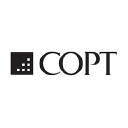/ factorpad.com / stocks / f53cmg.html
An ad-free and cookie-free website.
Our quantitative data points are meant to provide a high-level understanding of factors in equity risk models for Corporate Office Properties. Portfolio managers use these models to forecast risk, optimize portfolios and review performance.
We show how OFC stock compares to 2,000+ US-based stocks, and to peers in the Finance and Insurance sector and Other Financial Vehicles industry.
Please do not consider this data as investment advice. Data is downloaded from sources we deem reliable, but errors may occur.
 Corporate Office Properties Trust (COPT) is a REIT that owns, manages, leases, develops and selectively acquires office and data center properties. The majority of its portfolio is in locations that support the United States Government and its contractors, most of whom are engaged in national security, defense and information technology ('IT') related activities servicing what it believes are growing, durable, priority missions ('Defense/IT Locations'). The Company also owns a portfolio of office properties located in select urban/urban-like submarkets in the Greater Washington, DC/Baltimore region with durable Class-A office fundamentals and characteristics ('Regional Office Properties'). As of December 31, 2020, the Company derived 87% of its core portfolio annualized rental revenue from Defense/IT Locations and 13% from its Regional Office Properties. As of the same date and including 17 properties owned through unconsolidated joint ventures, COPT's core portfolio of 179 office and data center shell properties encompassed 20.8 million square feet and was 95.0% leased; the Company also owned one wholesale data center with a critical load of 19.25 megawatts that was 86.7% leased.
Corporate Office Properties Trust (COPT) is a REIT that owns, manages, leases, develops and selectively acquires office and data center properties. The majority of its portfolio is in locations that support the United States Government and its contractors, most of whom are engaged in national security, defense and information technology ('IT') related activities servicing what it believes are growing, durable, priority missions ('Defense/IT Locations'). The Company also owns a portfolio of office properties located in select urban/urban-like submarkets in the Greater Washington, DC/Baltimore region with durable Class-A office fundamentals and characteristics ('Regional Office Properties'). As of December 31, 2020, the Company derived 87% of its core portfolio annualized rental revenue from Defense/IT Locations and 13% from its Regional Office Properties. As of the same date and including 17 properties owned through unconsolidated joint ventures, COPT's core portfolio of 179 office and data center shell properties encompassed 20.8 million square feet and was 95.0% leased; the Company also owned one wholesale data center with a critical load of 19.25 megawatts that was 86.7% leased.
Many of the following risk metrics are standardized and transformed into quantitative factors in institutional-level risk models.
Rankings below represent percentiles from 1 to 100, with 1 being the lowest rating of risk.
Stocks with higher beta exhibit higher sensitivity to the ups and downs in the market. (↑↑)
Stocks with higher market capitalization often have lower risk. (↑↓)
Higher average daily dollar volume over the past 30 days implies lower liquidity risk. (↑↓)
Higher price momentum stocks, aka recent winners, equate to lower risk for many investors. (↑↓)
Style risk factors often include measures of profitability and payout levels.
Companies with higher earnings generally provide lower risk. (↑↓)
Companies with higher dividend yields, if sustaintable, are perceived to have lower risk. (↑↓)
/ factorpad.com / stocks / f53cmg.html
A newly-updated free resource. Connect and refer a friend today.